A highway runs through the muscular folds of the high Andes mountains of the Cajas National Park. Dramatic mountains stretch out in every direction, but here, above the treeline, landscape looks barren. The mountains are covered in variations of grey-green pillowy tufts of grass referred to in Ecuador as the “paramo” and “paja”. This grass cover seems fairly uniform.
But get closer. Walk through the paramo; pick your way through the paja and get to know it intimately around your ankles and knees. It reveals delightful sudden bursts of color and form. Among the grasses and the rocks and soil are unique wildflowers endemic to the high alpine regions of the Andes. Their presence is always a delight, a demonstration of the infinite variation that nature can produce in the infinitely distinct, unique, places to be found on the planet. Their iridiscence is dazzling amidst the “plain” cover of the paja. The wildflowers persist under the most difficult range of conditions, from blazing equatorial sun to freezing high-altitude winds.
Ecuador, like its neighbor Columbia, is a flower power in global trade. It exports cultivated flowers to the United States and other major global markets. Extravagant and showy lilies, orchids, birds of paradise, roses, carnations, and daisies are bred and grown in agricultural greenhouses and fields. Then, they are cut, packaged and flown daily to international hubs like Miami, where they are distributed further. Manipulated and harnessed by human hands, these flowers delight our senses, feed the global demand for beauty, and rake in profits.
But the wildflowers endemic to these high mountains are not ostentatious and plump and juicy. They don’t dazzle with their ornate forms, articulated petals, juicy stamen, and vivid patterns. These wildflowers wouldn’t stay preserved in plastic wrap and boxes for days on end in dark holds of aircraft that traverse continents and oceans. Yet, they are strong. When you see them in the mountains you instantly recognize that they are tenacious, beautiful creatures who have intelligently adapted to a harsh environment. In these mountains, the equatorial sun beats down mercilessly, alternating with the biting, damp cold of clouds and rain that roll in regularly at these high altitudes. Their bold color and sentience, bobbing in the mountain winds, will immediately catch your eye. The sense of their “life” will connect to a pulse alive in your own body.
This blog is a collection of my wildflower photos from multiple hikes. I have posted common names because I would like the names to be accessible to as many hikers and casual recreational walkers of the Cajas as possible. When you know the names of these gorgeous creatures, you will find the landscape come alive with intelligence, fragility, and beauty. In too many instances, you will find I have only identified the flower as a member of the “Asteraceae” family. There are many specimens of the Asteraceae family in this area of southern Ecuador but I don’t know their names. I invite people to contact me with their names.
1.Common name: “Lancetilla”. This showy specimen is endemic to southern Ecuador. The showiest red parts of the plants are “bracts” not flowers.
2. Common name: “Flor de la montana” or “Chuquiragua”. Orange spiny bracts on shrubs that grow in the grassy paramo all around the Cajas.
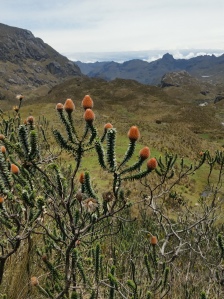
3. Unidentified from the Asteraceae or Compositae family.
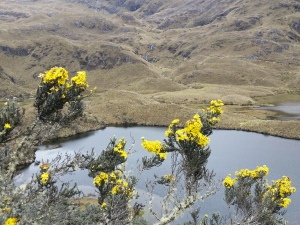
4. Common name: “Aguarongo”. These are perfectly symmetrical basal rosettes, but can grow up to 1 meter in diameter. A characteristic feature of the Cajas landscape.
5. Common name: “Cacho de venado”. These red cylindrical stems are set in “cushion paramo”, a type of grass that grows like little cushions low to the ground.
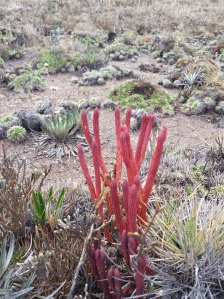
6. Unidentified member of the Asteraceae o Compositae family.
7. Unidentified member of the Asteraceae o Compositae family
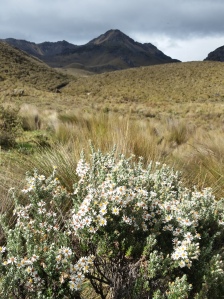
8. Common name: “Espino blanco”. These interesting flowers grow at ground level, and in cushions.
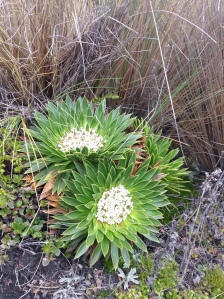
9. Common name: “Sarashima” or “Globito”. They grow low to the ground and have bright orange-yellow profile outlined in red. These beauties are endemic to the Cajas National Park.
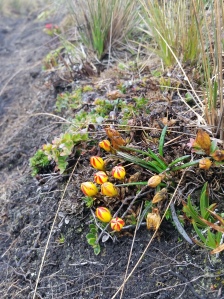
10. No common name given. “Ourisia chamaedrifolia” Solitary and tubular bell-shaped red flowers, seem to hang down. Found low to the ground.
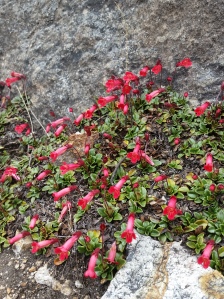
11. Another gorgeous variation of the Asteraceae or Compositae family.
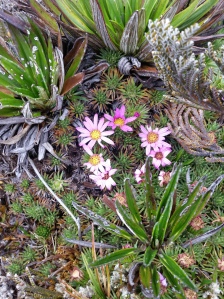
12. Don’t know this one.

13. Unknown orange flower

14. Unknown and unique beauty.
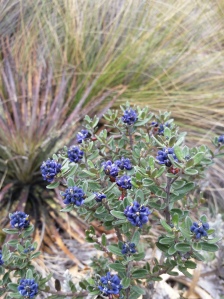
15. Incredible stunning community of purplish-grassy flowers
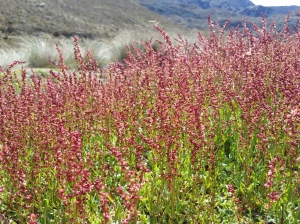
16. Common name: “Zarza” or “Zarcillo Sacha”. These shrubs are about a meter tall and their flowers hang like pendants in pairs. They have pinkish-red bracts and sepals, and the inner petals of the hanging flower are purple.





